The 25 Healthiest Carbs You Can Eat
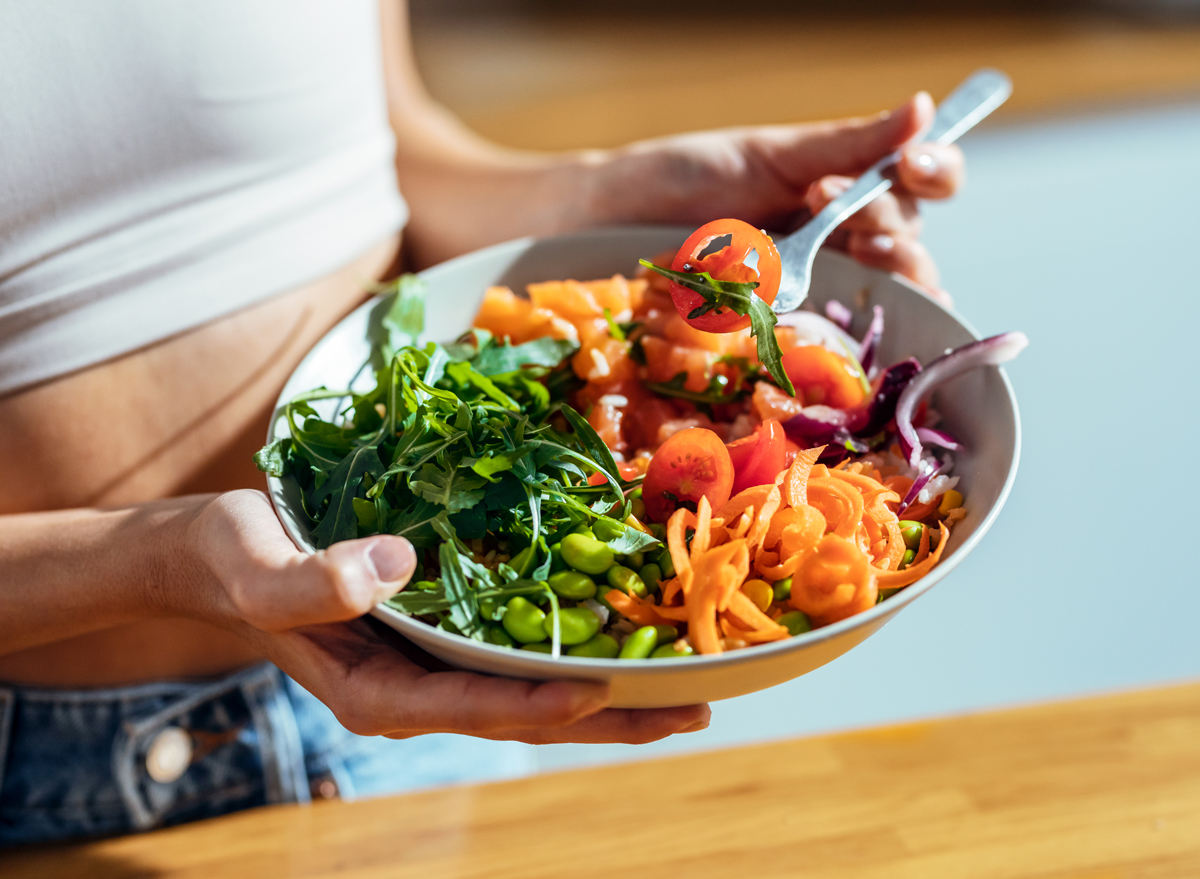
Carbs get a bad rap for contributing to weight gain and for upping one's risk for diabetes and heart disease. But not all carbs are created equal. Refined, simple carbs like table sugar, syrups, candy, white flour, and baked goods are considered low-quality carbohydrates as they lack essential nutrients and fiber and they can cause your blood sugar and insulin levels to spike. Wholesome, healthy carbs, like those that provide fiber, vitamins, minerals, and bioactive compounds can help prevent chronic conditions and will even help with weight management.
Carbohydrates are an essential nutrient as they play an important role in the healthfulness of one's diet. This macronutrient provides the fuel for your brain to function and for muscles to contract, from blinking your eye to flexing your biceps.
Here are the 25 healthiest carbs to enjoy as part of a healthy diet and lifestyle.
Oats
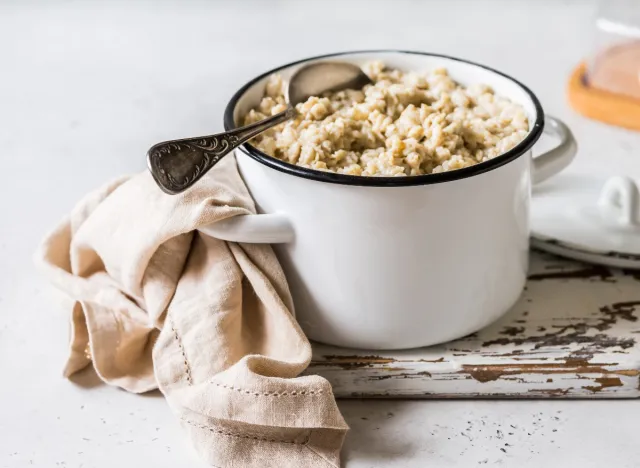
Oats are one of the healthiest whole-grain carbs to enjoy not only for breakfast but anytime during the day. This healthy carb has five different approved health claims in Europe that cover heart health, blood sugar control, and more. Oats provide beta-glucan, a soluble fiber that helps keep you satisfied and plays a role in weight management. One recent study found that obese individuals who took an oat supplement on a calorie-controlled diet lost more belly fat and total body fat, compared to those who didn't get the oat supplement. Oats not only reduce appetite they help lower oxidative stress that can contribute to several chronic conditions.
Sweet Potatoes
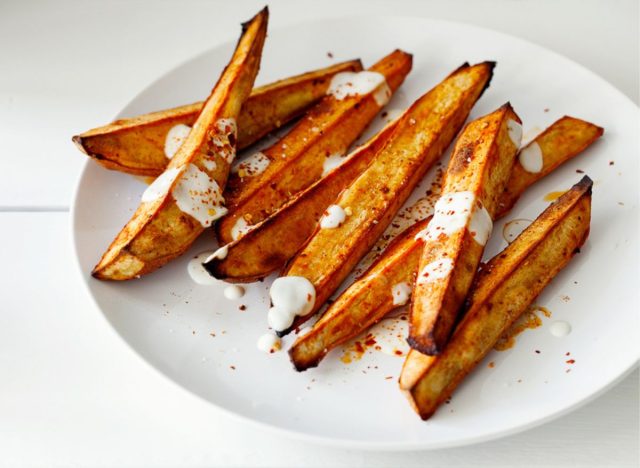
Sweet potatoes are rich in vitamins A (beta-carotene) and C, B vitamins, potassium, antioxidants, and fiber. They are a great healthy carbohydrate to enjoy year-round in a myriad of ways. They are a healthful addition to your breakfast smoothies, soups, and desserts. A medium, baked sweet potato is about 100 calories, 26 grams of carbs, and 4 grams of fiber. The slow-releasing carbs and fiber can keep you satisfied longer to help with weight management. It has more than 100% of your daily vitamin A requirement, in the form of beta-carotene. Studies suggest that diets rich in beta-carotene may provide anti-cancer and other health-promoting properties.
Whole Wheat Pearl Couscous
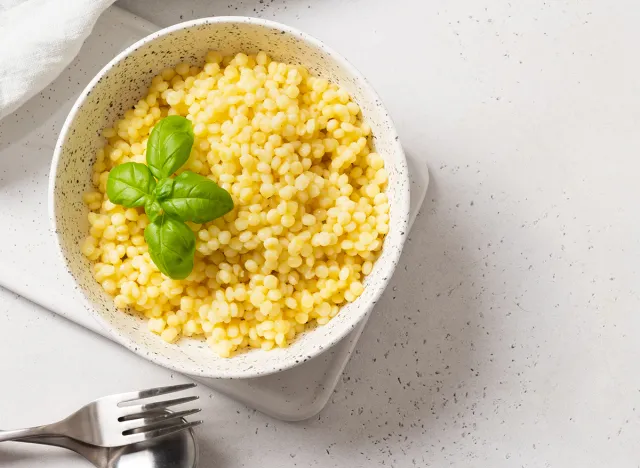
Couscous is native to North Africa, but it has become a popular healthy carb worldwide. Couscous is traditionally made from durum wheat and is a good source of plant-based protein and selenium. A half-cup cooked couscous has about 90 calories and 1 gram of fiber and is a good source of selenium, B vitamins, plant-based protein, and several other trace minerals. Choose whole wheat pearl couscous for the most nutrition and health benefits.
Brown Rice
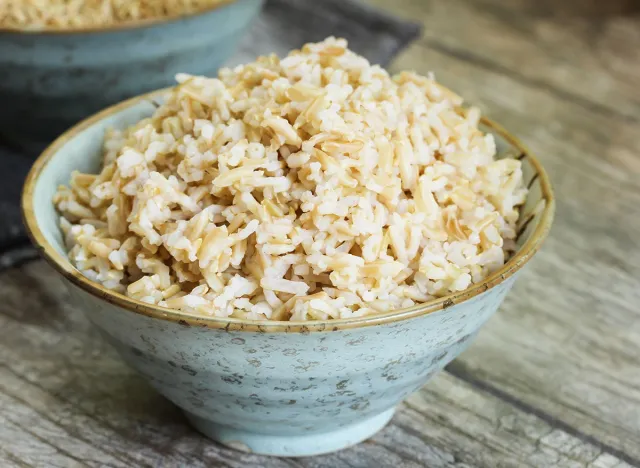
This whole grain has more fiber, vitamins, minerals, and other bioactive compounds compared to more refined white rice. A half-cup serving of brown rice has around 120 calories, 2 grams of fiber, and 3 grams of protein. Brown rice is a 100% whole grain and one study reported in the Journal of Nutritional Science and Vitaminology found that brown rice and other colored rice varieties process high levels of bioactive compounds.
100% Whole Grain Bread
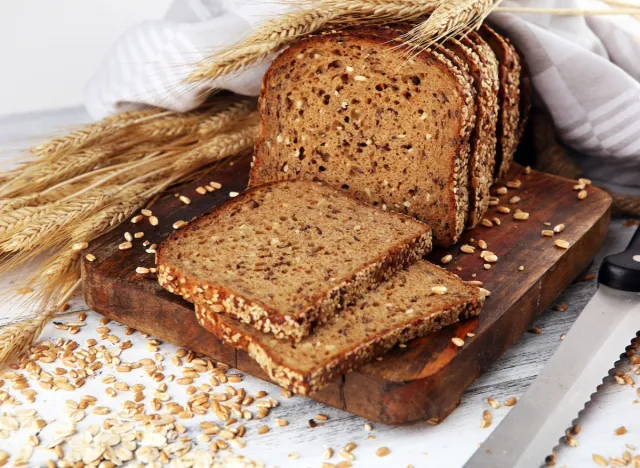
Whole grain bread retains the nutrient-rich bran, germ, and endosperm, providing more dietary fiber, vitamins, and minerals compared to more refined white bread. A slice of whole-grain bread has about 80 calories, 4 grams of protein, 12 grams of carbohydrates, and at least 2 grams of fiber. The high fiber content supports digestive health and whole grain intake is associated with a lower risk of chronic diseases, including heart disease and type 2 diabetes, due to its ability to help maintain stable blood sugar levels and improve cholesterol profiles.
A meta-analysis of 45 published studies published in BMJ with 45 studies found that whole grain intake is associated with a reduced risk of coronary heart disease, cardiovascular disease, and total cancer, and mortality from all causes, respiratory diseases, infectious diseases, diabetes, and all non-cardiovascular, non-cancer causes. A slice of whole-grain bread counts as one whole-grain serving. It's recommended to get at least three servings of whole grains per day for their health benefits.
Strawberries
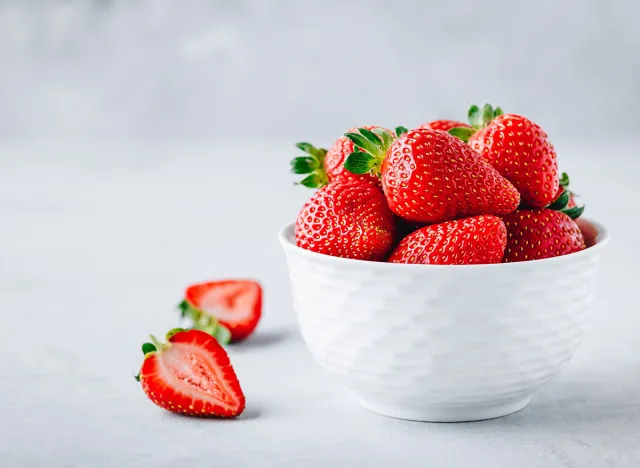
A true superfood, strawberries are packed with vitamin C, fiber, potassium, folate, and beneficial antioxidants. The red-hued berries also contain several bioactive flavonoids that are known to help protect against chronic diseases, including type 2 diabetes, and obesity and they may help stave off some types of dementia.
Strawberries are a proven heart-healthy choice. One study reported that those who ate at least three servings per week of anthocyanin-rich strawberries (as well as blueberries) reduced their risk of a heart attack by more than 30 percent. A cup of fresh strawberries contains just 50 calories, 12 grams of carbohydrates, and 3 grams of fiber.
Blueberries
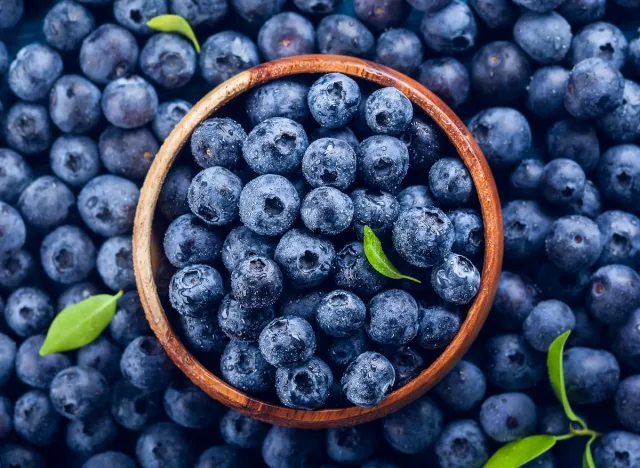
Blueberries are often considered a mind-boosting food due to research that shows blueberries may help keep your mind sharp as you age. Packed with fiber, vitamin C, and antioxidants, particularly anthocyanins, blueberries demonstrate anti-inflammatory and neuroprotective properties, potentially contributing to cognitive function and reducing the risk of age-related cognitive decline. Their high vitamin C content supports immune health, while the presence of dietary fiber aids in digestion and may help manage blood sugar levels. A study published in Advances in Nutrition highlights the healthful properties of blueberries including combating oxidative stress and promoting overall health. A cup provides 80 calories, 4 grams of filling fiber, and 21 grams of carbohydrates.
Raspberries
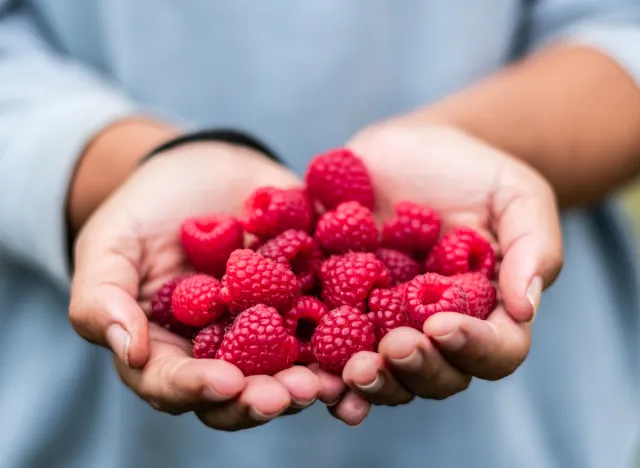
These vibrant berries are rich in antioxidants, particularly anthocyanins and quercetin, which have been linked to anti-inflammatory and anti-cancer properties. Additionally, raspberries have more fiber and less natural sugars than most fruits. A cup of raspberries has 65 calories and packs in 8 grams of fiber and just 5 grams of natural sugars. The moderate calories, high fiber, and low sugar counts promote digestive health and aid in weight management. One lab study published in the Journal of Agricultural and Food Chemistry highlights the potent antioxidant capacity of these healthy carbs, attributing it to their polyphenolic compounds, and the ability of raspberry extracts to inhibit cell growth of certain types of human cancers, including breast, oral, colon and prostate.
Oranges
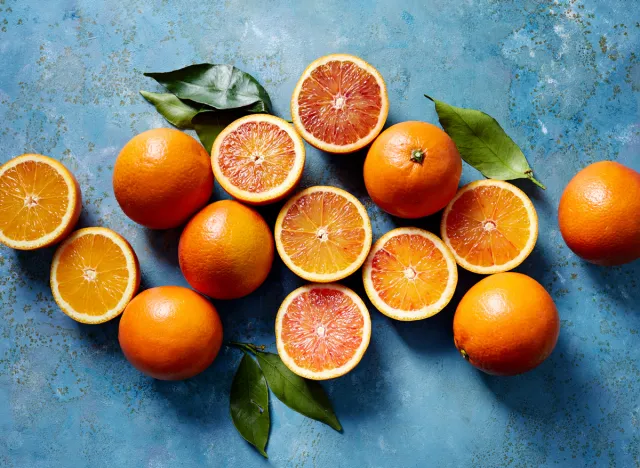
Rich in vitamin C and myriad antioxidant phytonutrients, oranges play a crucial role in supporting the immune system, promoting collagen formation, and acting as a potent antioxidant to combat oxidative stress. Additionally, oranges contain dietary fiber, aiding in digestion and supporting heart health by helping to manage cholesterol levels. The fruit's natural sugars are accompanied by a low glycemic index, making it a nutritious choice for those mindful of blood sugar levels. Research indicates that regular consumption of oranges may contribute to a reduced risk of chronic diseases, including heart disease, type 2 diabetes, systemic inflammation, dementia, and more. One study published in Frontiers in Immunology reported that consuming orange juice daily reduced markers of reduce markers of inflammation, including C-reactive protein, as confirmed through a recent meta-analysis.
Grapefruit
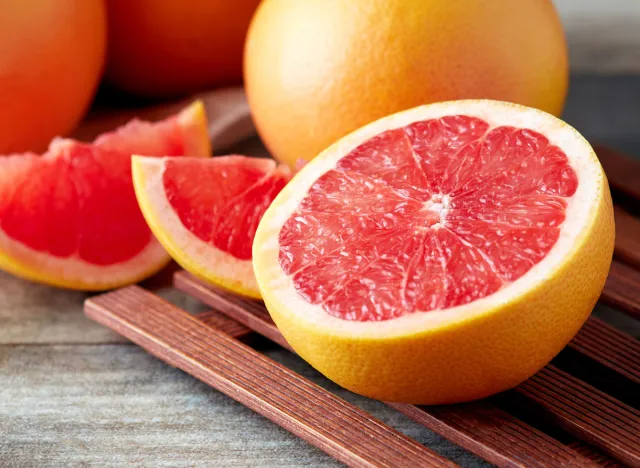
This tangy citrus fruit boasts an array of nutritional and health benefits. Rich in vitamin C, antioxidants, and fiber, grapefruit supports a robust immune system and aids in digestive health. Numerous studies have highlighted its potential role in weight management, as compounds like naringin and flavonoids may contribute to metabolic regulation and reduction of insulin resistance. Additionally, research published in Frontiers in Nutrition suggests that grapefruit provides vascular benefits that may help reduce the risk for cardiovascular disease. Half a medium grapefruit provides 50 calories, 2 grams of fiber, and 13 grams of carbs.
Bran Flake Cereal
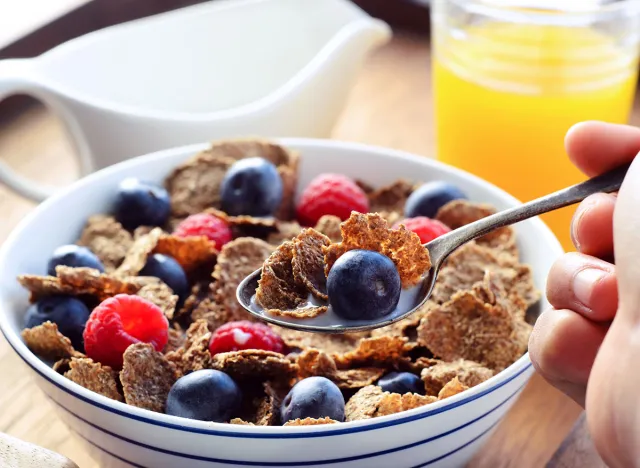
Packed with whole grains, bran flakes are one of the higher-fiber cereals that can keep your GI tract on track. The fiber content also aids in maintaining stable blood sugar levels and may contribute to a lower risk of heart disease. Additionally, bran flakes often contain essential vitamins and minerals, such as B vitamins, iron, and folic acid. A bowl of bran flakes can provide 7 to 10 grams of fiber, or about one-third of your daily fiber goal. According to a review study published in the BMJ individuals with higher whole grain intake, including whole grain bran cereal, is associated with a reduced risk of coronary heart disease, cardiovascular disease, certain types of cancer, diabetes, infectious disease, and an overall reduction in risk for death.
Beets
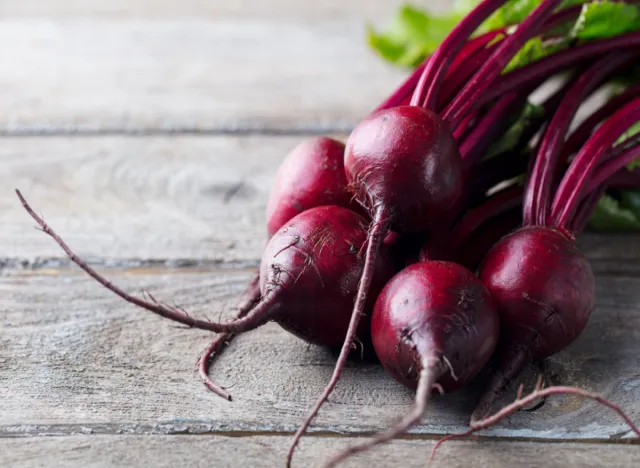
Beets provide unique compounds—nitrates and betalains—which can help the body transfer oxygen to muscles more efficiently, aid muscle contraction, lower blood pressure, and act as potent antioxidants. A study published in the Journal of Agriculture and Food Chemistry reported that betalins are associated with important cardioprotective benefits and may help temper inflammation associated with muscle-damaging exercise. In addition, other research shows that beetroot juice as well as cooked beets can improve performance when eaten pre-exercise but they also have post-exercise benefits too.
Apples
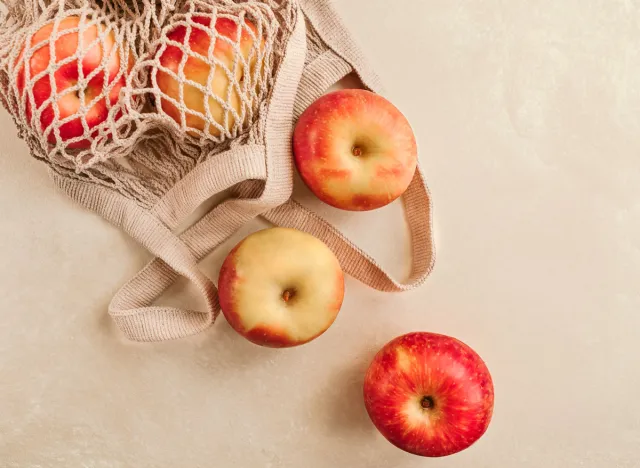
Apples are a good source of vitamin C, fiber, and beneficial antioxidants. Research shows that apples can help with weight loss, and may help reduce the risk of type 2 diabetes, heart disease, and may help prevent certain types of cancer, according to research. A medium apple has about 95 calories and 4.5 grams of fiber and provides about 10% of the vitamin C you need each day. Be sure to eat the peel as that is where most of the fiber and antioxidants are found.
Chickpeas
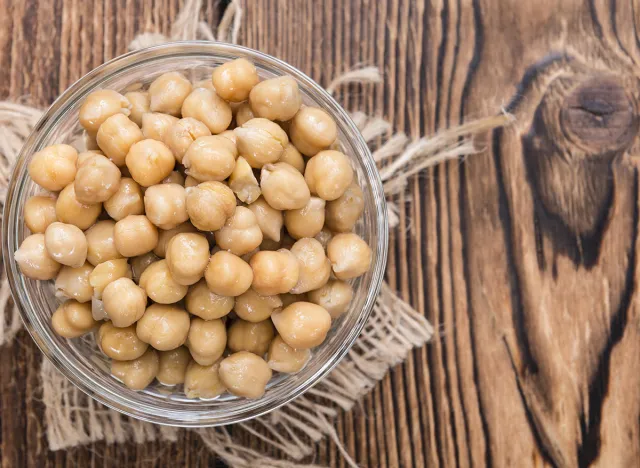
Chickpeas (aka garbanzo beans) are often hailed as a nutritional powerhouse, due to the fiber, protein, vitamins, and minerals they provide. A half-cup of cooked chickpeas provides around 7 grams of plant-based protein and They are notably rich in folate and iron. Chickpeas are heart-healthy and can help lower harmful cholesterol levels and the fiber and protein help contribute to feelings of fullness. According to research, chickpeas and hummus also contain dietary bioactives such as phytic acid, sterols, tannins, carotenoids, and other polyphenols that provide myriad health benefits.
Lentils
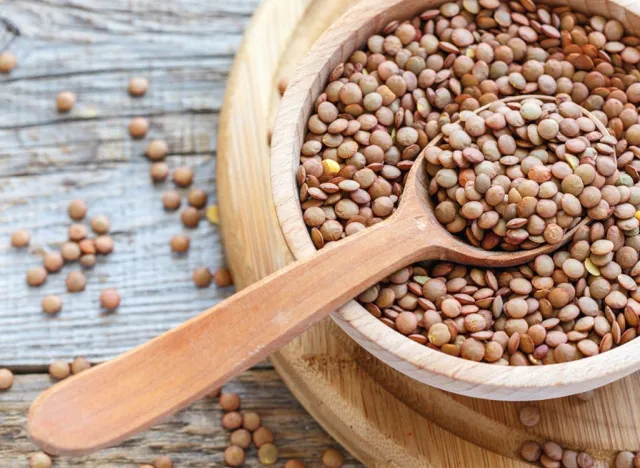
Packed with essential nutrients such as protein, fiber, iron, and folate, lentils are heart-healthy, aid digestion, and help stabilize blood sugar and insulin levels. Their high fiber content promotes a feeling of fullness, aiding in weight management, while their low glycemic index helps regulate blood glucose. Additionally, lentils contain significant amounts of antioxidants and phytochemicals that may contribute to reducing the risk of chronic diseases. A study published in the International Journal of Molecular Sciences reported that lentils are rich in beneficial polyphenols that help reduce the risk of diabetes, coronary artery disease, and obesity, and reduce inflammation.
Black Beans
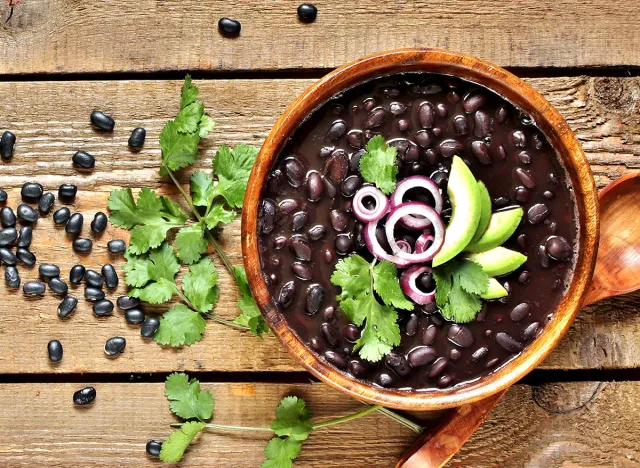
Black beans are a nutrient-dense legume packed with protein, fiber, vitamins, and minerals. The high fiber content aids in digestion and helps regulate blood sugar levels. Additionally, black beans are a rich source of folate, iron, magnesium, and antioxidants, which play crucial roles in various bodily functions, including energy metabolism and immune system support. A study reported in the journal Nutrients reported that black beans reduced body fat, blood sugar, and insulin levels and improved gut microbiota.
Bananas
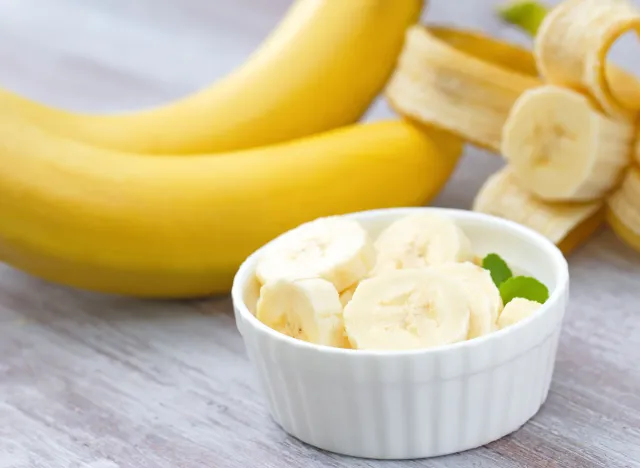
The most popular fruit in the world provides some significant health and nutrition benefits. A medium-sized banana provides around 110 calories, 30 grams of carbs, and 3 grams of filling fiber. Bananas are an excellent source of vitamin B6 with 25% of your daily recommended intake. They're also a good source of potassium, vitamin C, and manganese. Bananas also contain many bioactive compounds, according to research published in Food Quality and Safety, including carotenoids and flavonoids, that are known to have myriad benefits —from helping to maintain eyesight to reducing risk for heart disease and certain types of cancer.
Carrots
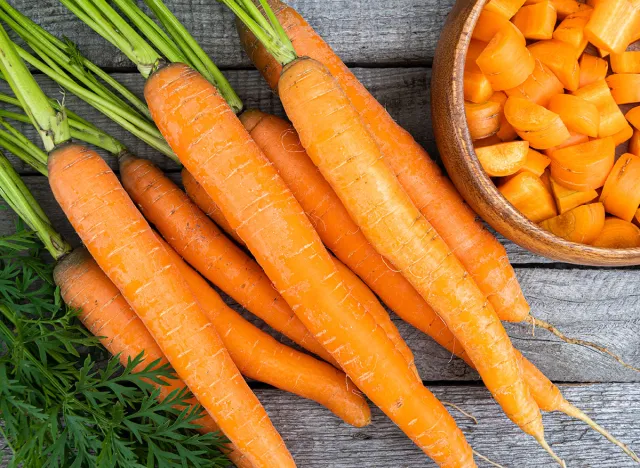
Packed with beta-carotene, a powerful antioxidant, and precursor to vitamin A, this root vegetable promotes optimal vision, supports a healthy immune system, and maintains skin health. Additionally, carrots' high fiber content aids in digestion, while the vitamins and minerals present, such as potassium and vitamin K, contribute to cardiovascular health and bone strength. According to a study published in the journal Foods, the bioactive compounds in these healthy carbs may reduce the risk of certain types of cancer and cardiovascular diseases due to their antioxidant, anti-inflammatory, plasma lipid modification, and anti-tumor properties.
Buckwheat
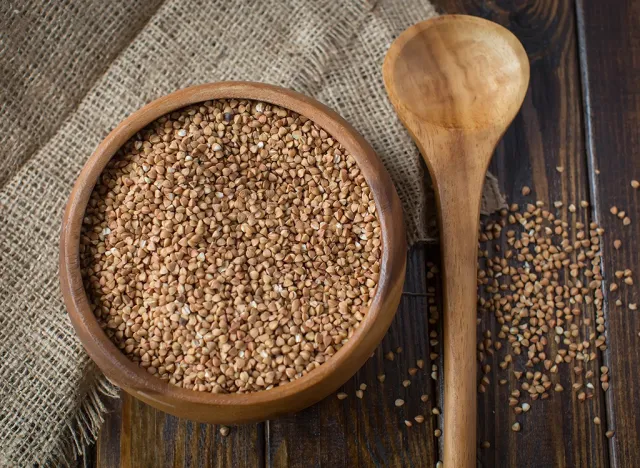
This whole grain also meets superfood status. It's packed with essential nutrients such as fiber, plant-based protein, vitamins, and minerals, buckwheat has been linked to improved heart health, better digestion, and stable blood sugar levels. A cup has about 6 grams of protein, 4.5 grams of fiber, and 33 grams of total carbs. It provides rutin, a flavonoid with antioxidant properties, which may help combat inflammation and oxidative stress. A study published in the journal Plants reveals that buckwheat may provide many health benefits due to its contents of resistant starch, mineral elements, proteins, and in particular, phenolic substances, which prevent the effects of several chronic human diseases, including hypertension, obesity, cardiovascular diseases, and gallstone formation.
Popcorn
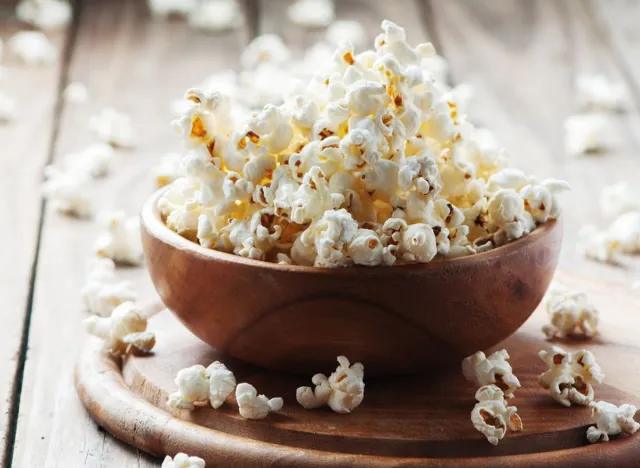
Popcorn is a great snack because it's a whole grain and you can enjoy a large volume of popcorn for a low number of calories. Popcorn is 100% whole grain and it provides protein, fiber, and antioxidants. A study published in the journal Antioxidants revealed that beneficial antioxidant polyphenols were more concentrated in popcorn compared to fruits and vegetables. The fiber in popcorn will help keep you satisfied so you're less likely to overeat. What's more, a cup of air-popped popcorn has just 30 calories, 6 grams of carbs, 1 gram of protein, and 1 gram of fiber, according to the USDA.
Quinoa
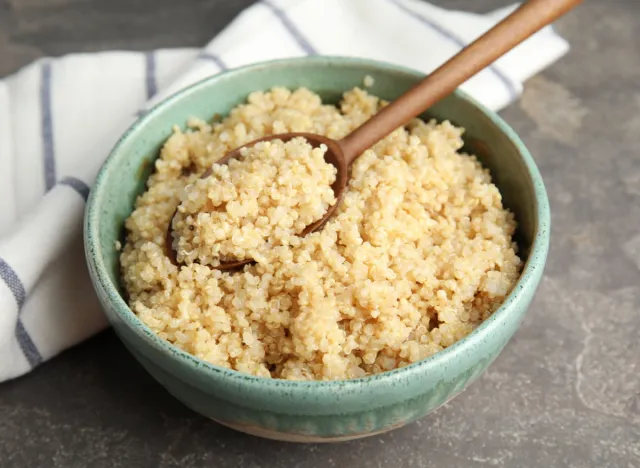
This plant native to South America is considered an ancient whole grain that provides more protein than most grains (4 grams per ½ cup cooked serving). It's considered a complete plant-based protein because it provides all the nine essential amino acids the body needs to function properly. Beyond protein, quinoa is rich in fiber (2.5 g per ½-cup serving), vitamins, and minerals, including magnesium, iron, and phosphorus. Moreover, research published in the journal Plants reports that the phenolic compounds in this healthy carb compounds may help maintain gut health, and they exert anticancer, anti-inflammatory, anti-obesity, antidiabetic, and cardioprotective effects.
Red Grapes
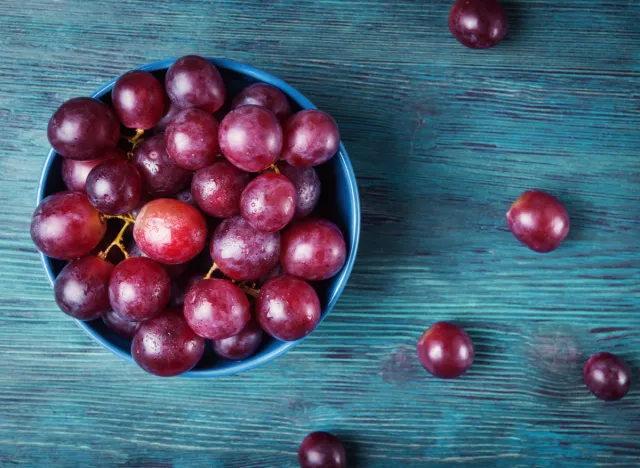
Red grapes provide about 90 calories per 3/4 -cup, 23 grams of carbs, and 1 gram of fiber. Grapes are a good source of fiber, potassium, vitamin K, and several other vitamins and minerals. They also contain quercetin and resveratrol is found in red grapes and has been shown in many studies to provide heart health, anti-inflammatory, anti-cancer, and other health benefits. Emerging research is studying the benefits of grape consumption on eye, brain, joint, bone, bladder, skin, colon health, and more.
Mangos
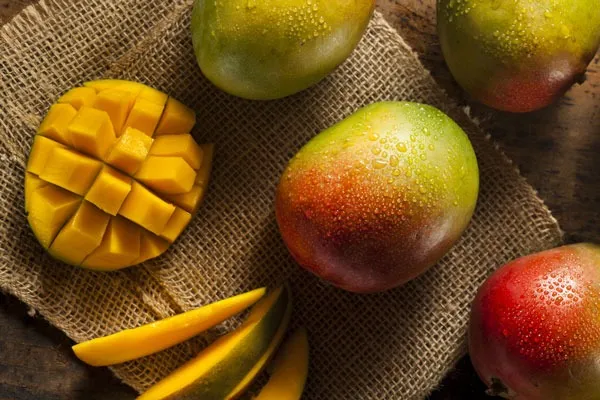
With more than 20 vitamins and minerals, mangos are loaded with good nutrition and health benefits, making them one of the best healthy carbs you can eat. Just one cup provides 100% of our daily vitamin C needs, helping to strengthen our immune system, keep our teeth and gums healthy, and support collagen formation to maintain skin health. Mangos are also rich in fiber to help with weight management. A ¾-cup serving has about 70 calories, 2 grams of fiber, and 19 grams of carbs. A study published in The Journal of Nutrition and Food Sciences reported that individuals who eat mangoes have healthier diets.
Barley
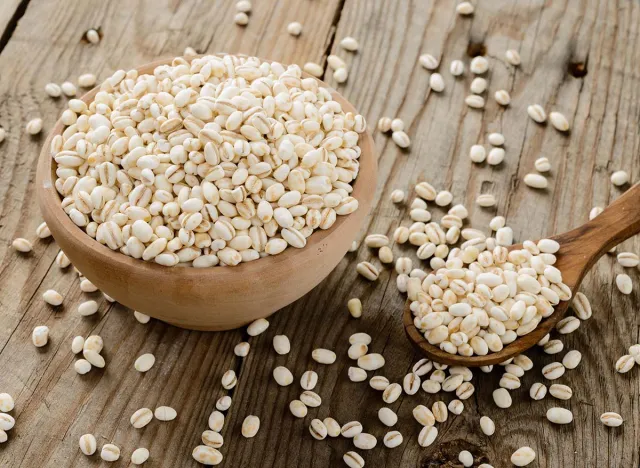
Like oats, barley also provides beta-glucan, the beneficial soluble fiber that can help lower harmful cholesterol and help you stay satisfied. Barley also contains beneficial phytonutrients that can help prevent chronic conditions. A serving of barley has about 80 calories, 17 grams of carbohydrates, and 4 grams of fiber. It's also rich in trace minerals like manganese and selenium.
Sweet Cherries
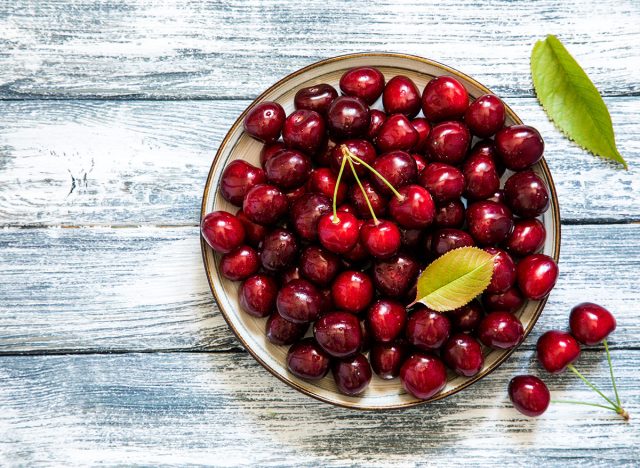
Cherries are nutritional all-stars. A serving of sweet cherries (1 cup) has 90 calories and 3 grams of fiber and is a good source of vitamin C and potassium. They're also a great source of bioactive compounds known as anthocyanins, which may have anti-inflammatory, anti-cancer, and cardiovascular benefits. Several studies indicate that cherries may help reduce inflammation and joint pain associated with arthritis and gout. The quercetin in cherries helps neutralize potential DNA damage caused by free radicals and may help protect against heart disease and certain cancers, including breast, colon, prostate, and lung.
- Source: El Shebini, S. M., Moaty, M. I. A., Fouad, S., Ahmed, N. H., & Tapozada, S. T. (2018). Obesity Related Metabolic Disorders and Risk of Renal Disease: Impact of Hypocaloric Diet and Avena Sativa Supplement. Open access Macedonian journal of medical sciences, 6(8), 1376–1381. https://doi.org/10.3889/oamjms.2018.292
- Source: van Poppel, G., & Goldbohm, R. A. (1995). Epidemiologic evidence for beta-carotene and cancer prevention. The American journal of clinical nutrition, 62(6 Suppl), 1393S–1402S. https://doi.org/10.1093/ajcn/62.6.1393S
- Source: Lee, J. S., Sreenivasulu, N., Hamilton, R. S., & Kohli, A. (2019). Brown Rice, a Diet Rich in Health Promoting Properties. Journal of nutritional science and vitaminology, 65(Supplement), S26–S28. https://doi.org/10.3177/jnsv.65.S26
- Source: Aune, D., Keum, N., Giovannucci, E., Fadnes, L. T., Boffetta, P., Greenwood, D. C., Tonstad, S., Vatten, L. J., Riboli, E., & Norat, T. (2016). Whole grain consumption and risk of cardiovascular disease, cancer, and all cause and cause specific mortality: systematic review and dose-response meta-analysis of prospective studies. BMJ (Clinical research ed.), 353, i2716. https://doi.org/10.1136/bmj.i2716
- Source: Cassidy, A., Mukamal, K. J., Liu, L., Franz, M., Eliassen, A. H., & Rimm, E. B. (2013). High anthocyanin intake is associated with a reduced risk of myocardial infarction in young and middle-aged women. Circulation, 127(2), 188–196. https://doi.org/10.1161/CIRCULATIONAHA.112.122408
- Source: Kalt, W., Cassidy, A., Howard, L. R., Krikorian, R., Stull, A. J., Tremblay, F., & Zamora-Ros, R. (2020). Recent Research on the Health Benefits of Blueberries and Their Anthocyanins. Advances in nutrition (Bethesda, Md.), 11(2), 224–236. https://doi.org/10.1093/advances/nmz065
- Source: Seeram, N. P., Adams, L. S., Zhang, Y., Lee, R., Sand, D., Scheuller, H. S., & Heber, D. (2006). Blackberry, black raspberry, blueberry, cranberry, red raspberry, and strawberry extracts inhibit growth and stimulate apoptosis of human cancer cells in vitro. Journal of agricultural and food chemistry, 54(25), 9329–9339. https://doi.org/10.1021/jf061750g
- Source: Miles, E. A., & Calder, P. C. (2021). Effects of Citrus Fruit Juices and Their Bioactive Components on Inflammation and Immunity: A Narrative Review. Frontiers in immunology, 12, 712608. https://doi.org/10.3389/fimmu.2021.712608
- Source: Krga, I., Corral-Jara, K. F., Barber-Chamoux, N., Dubray, C., Morand, C., & Milenkovic, D. (2022). Grapefruit Juice Flavanones Modulate the Expression of Genes Regulating Inflammation, Cell Interactions and Vascular Function in Peripheral Blood Mononuclear Cells of Postmenopausal Women. Frontiers in nutrition, 9, 907595. https://doi.org/10.3389/fnut.2022.907595
- Source: Aune, D., Keum, N., Giovannucci, E., Fadnes, L. T., Boffetta, P., Greenwood, D. C., Tonstad, S., Vatten, L. J., Riboli, E., & Norat, T. (2016). Whole grain consumption and risk of cardiovascular disease, cancer, and all cause and cause specific mortality: systematic review and dose-response meta-analysis of prospective studies. BMJ (Clinical research ed.), 353, i2716. https://doi.org/10.1136/bmj.i2716
- Source: Kanner, J., Harel, S., & Granit, R. (2001). Betalains--a new class of dietary cationized antioxidants. Journal of agricultural and food chemistry, 49(11), 5178–5185. https://doi.org/10.1021/jf010456f
- Source: Muggeridge, D. J., Howe, C. C., Spendiff, O., Pedlar, C., James, P. E., & Easton, C. (2014). A single dose of beetroot juice enhances cycling performance in simulated altitude. Medicine and science in sports and exercise, 46(1), 143–150. https://doi.org/10.1249/MSS.0b013e3182a1dc51
- Source: Boyer, J., & Liu, R. H. (2004). Apple phytochemicals and their health benefits. Nutrition journal, 3, 5. https://doi.org/10.1186/1475-2891-3-5
- Source: Wallace, T. C., Murray, R., & Zelman, K. M. (2016). The Nutritional Value and Health Benefits of Chickpeas and Hummus. Nutrients, 8(12), 766. https://doi.org/10.3390/nu8120766
- Source: Ganesan, K., & Xu, B. (2017). Polyphenol-Rich Lentils and Their Health Promoting Effects. International journal of molecular sciences, 18(11), 2390. https://doi.org/10.3390/ijms18112390
- Source: Sánchez-Tapia, M., Hernández-Velázquez, I., Pichardo-Ontiveros, E., Granados-Portillo, O., Gálvez, A., R Tovar, A., & Torres, N. (2020). Consumption of Cooked Black Beans Stimulates a Cluster of Some Clostridia Class Bacteria Decreasing Inflammatory Response and Improving Insulin Sensitivity. Nutrients, 12(4), 1182. https://doi.org/10.3390/nu12041182
- Source: Jiwan S Sidhu, Tasleem A Zafar, Bioactive compounds in banana fruits and their health benefits, Food Quality and Safety, Volume 2, Issue 4, December 2018, Pages 183–188, https://doi.org/10.1093/fqsafe/fyy019
- Source: Ahmad, T., Cawood, M., Iqbal, Q., Ariño, A., Batool, A., Tariq, R. M. S., Azam, M., & Akhtar, S. (2019). Phytochemicals in Daucus carota and Their Health Benefits-Review Article. Foods (Basel, Switzerland), 8(9), 424. https://doi.org/10.3390/foods8090424
- Source: Luthar, Z., Golob, A., Germ, M., Vombergar, B., & Kreft, I. (2021). Tartary Buckwheat in Human Nutrition. Plants (Basel, Switzerland), 10(4), 700. https://doi.org/10.3390/plants10040700
- Source: Coco, M. G., Jr, & Vinson, J. A. (2019). Analysis of Popcorn (Zea mays L. var. everta) for Antioxidant Capacity and Total Phenolic Content. Antioxidants (Basel, Switzerland), 8(1), 22. https://doi.org/10.3390/antiox8010022
- Source: https://fdc.nal.usda.gov/fdc-app.html#/food-details/167959/nutrients
- Source: Hussain, M. I., Farooq, M., Syed, Q. A., Ishaq, A., Al-Ghamdi, A. A., & Hatamleh, A. A. (2021). Botany, Nutritional Value, Phytochemical Composition and Biological Activities of Quinoa. Plants (Basel, Switzerland), 10(11), 2258. https://doi.org/10.3390/plants10112258
- Source: Vislocky, L. M., & Fernandez, M. L. (2010). Biomedical effects of grape products. Nutrition reviews, 68(11), 656–670. https://doi.org/10.1111/j.1753-4887.2010.00335.x
- Source: Zhang, Y., Neogi, T., Chen, C., Chaisson, C., Hunter, D. J., & Choi, H. K. (2012). Cherry consumption and decreased risk of recurrent gout attacks. Arthritis and rheumatism, 64(12), 4004–4011. https://doi.org/10.1002/art.34677
- Source: Brito, A. F., Ribeiro, M., Abrantes, A. M., Pires, A. S., Teixo, R. J., Tralhão, J. G., & Botelho, M. F. (2015). Quercetin in Cancer Treatment, Alone or in Combination with Conventional Therapeutics?. Current medicinal chemistry, 22(26), 3025–3039. https://doi.org/10.2174/0929867322666150812145435









